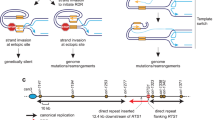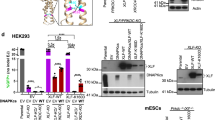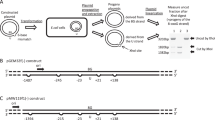Abstract
The mechanism by which mammalian cells replicate DNA containing pyrimidine dimers is poorly understood. When DNA synthesis is initiated after UV-irradiation in bacteria, parental DNA containing pyrimidine dimers has been shown to ‘exchange’ into the daughter strand DNA by a recA-dependent mechanism1–3. In earlier experiments, when growing mammalian cells were UV-irradiated and then incubated with labelled thymidine, pyrimidine dimers were initially interpreted to be in the newly synthesized DNA4, but later were found to be only adjacent to newly synthesized DNA in daughter strand present before UV treatment5. A way to avoid these problems of interpretation would be to use cells in G0 or G1 which are not synthesizing DNA at the time of irradiation. UV damage could then be detected in a very sensitive quantitative assay such as that recently described using alkaline elution and an endonuclease preparation from Micrococcus luteus6. I have now used this approach and report that up to 3 dimers per 109 daltons of daughter strand DNA could be detected 34–45 h after UV-irradiation in human peripheral blood lymphocytes (PBL), normal human fibroblasts, group A xeroderma pigmentosum (XP) fibroblasts and mouse 3T3 cells. This represents approximately 1–3% of the dimers present in the parent strand at this time after UV.
This is a preview of subscription content, access via your institution
Access options
Subscribe to this journal
Receive 51 print issues and online access
$199.00 per year
only $3.90 per issue
Buy this article
- Purchase on Springer Link
- Instant access to full article PDF
Prices may be subject to local taxes which are calculated during checkout
Similar content being viewed by others
References
Rupp, W. P., Wilde, C. E., Reno, D. L. & Howard-Flanders, P. J. molec. Biol. 61, 25–44 (1971).
Hanawalt, P. C., Cooper, P. K., Ganesan, A. K. & Smith, C. A. A. Rev. Biochem. 48, 783–836 (1979).
Dressler, D. & Potter, H. A. Rev. Biochem. 51, 727–761 (1982).
Buhl, S. N. & Regan, J. D. Nature 246, 484 (1973).
Lehmann, A. R. & Kirk-Bell, S. Photochem. Photobiol. 27, 297–307 (1978).
Fornace, A. J. Jr Mutat. Res. 94, 263–276 (1982).
Kohn, K. W., Erickson, L. C., Ewig, R. A. G. & Friedman, C. A. Biochemistry 15, 4628–4637 (1976).
Nagasawa, H., Robertson, J. & Little, J. B. Radiat. Res. 83, 368–369 (1980).
Nagasawa, H. & Little, J. B. Radiat. Res. 91, 301 (1982).
Darzynkiewicz, Z., Traganos, F., Sharpless, T. & Melamed, M. R. Proc. natn. Acad. Sci. U.S.A. 73, 2881–2884 (1976).
Robbins, J. H. Ann. intern. Med. 80, 221–248 (1974).
Paterson, M. C. Adv. Radiat. Biol. 7, 1–53 (1978).
Laval, J. Nature 269, 829–832 (1977).
Riazuddin, S. & Grossman, L. J. biol. Chem. 252, 6280–6286 (1977).
Latt, S. A. A. Rev. Genet. 15, 11–55 (1981).
Holliday, R. Genet. Res., Camb. 5, 282–304 (1964).
Wolgemuth, D. J. & Hsu, M. Nature 287, 168–170 (1980).
Small, J. & Scangos, G. Science 219, 174–176 (1983).
Lavin, M. F. Biophys. J. 23, 247–255 (1978).
Cunningham, R. P., Wu, A. M., Shibata, T., DasGupta, C. & Radding, C. M. Cell 24, 213–223 (1981).
Loveday, K. S. & Latt, S. A. Nucleics Acid Res. 5, 4087–4104 (1978).
Kantor, G. J. & Setlow, R. B. Cancer Res. 41, 819–825 (1981).
Carrier, W. L. & Setlow, R. B. J. Bact. 102, 178–186 (1970).
Author information
Authors and Affiliations
Rights and permissions
About this article
Cite this article
Fornace, A. Recombination of parent and daughter strand DNA after UV-irradiation in mammalian cells. Nature 304, 552–554 (1983). https://doi.org/10.1038/304552a0
Received:
Accepted:
Issue Date:
DOI: https://doi.org/10.1038/304552a0
This article is cited by
-
In search of the tumour-suppressor functions of BRCA1 and BRCA2
Nature (2000)
-
DNA polymerase stalling, sister chromatid recombination and the BRCA genes
Oncogene (2000)
-
Molecular cloning of a mammalian gene involved in the fixation of UV-induced mutations
Somatic Cell and Molecular Genetics (1990)
Comments
By submitting a comment you agree to abide by our Terms and Community Guidelines. If you find something abusive or that does not comply with our terms or guidelines please flag it as inappropriate.



